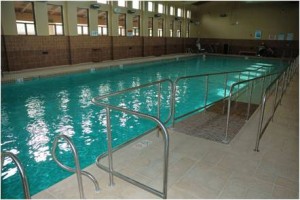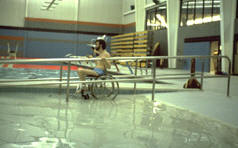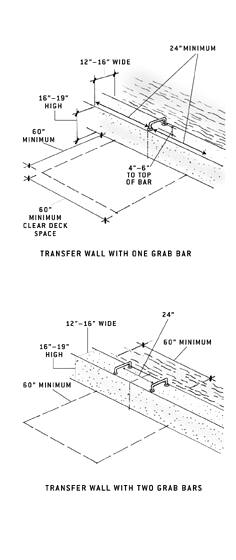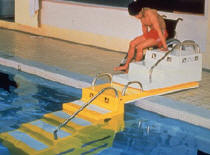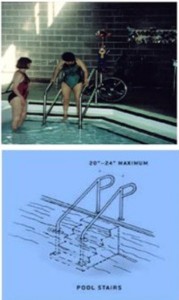One of the confusing parts of the Standards is work areas. Areas designated for work are partially exempted in the Americans with Disabilities Act (ADA). They are not exempted in the Architectural Barriers Act (ABA). But what parts are truly exempted? What parts can be adaptable? Which parts have to fully comply? This newsletter will attempt at clearing things
Work Areas vs. Employee Spaces
In the ADA, a work area is exempted from having to be fully accessible. The only requirement for work areas is an approach to the primary entrance, the ability to enter and the ability to exit. The rest of the area does not have to comply.
Notice the figure above: only maneuvering clearances on the exterior of the work area door is required to be provided. No maneuvering clearances at the door on the interior is required.
Anything inside the work area will not have to be made accessible. This requirement is for
Title III entities (public accommodations and commercial facilities) and for building access only. Title I on the other hand states that a person cannot be fired or not hired based on their disability and if they are hired, they must have accessible accommodations.
So in essence, the building owner can defer the accessible work areas until they are needed.
But what is a “work area”? It is defined as a space or area where a task is performed that is part of the job description and requirement.
What about an employee restroom, locker rooms or employee break room? Those are NOT considered “work areas”. They are considered Common Use areas and must be accessible.
The 2010 ADA Standards require that swimming pools, wading pools and spas be made accessible to the disabled community. Existing pools also have to comply , but the Department of Justice allows that to happen “as it is readily achievable”. This newsletter explains what the requirements are and what the deadlines to comply will be.
ADA Section 242 Swimming Poools, Wading Pools and Spas
For swimming pools to be accessible they must have at least one accessible means of entry. The ADA Standards allows the following methods of entry into a pool:
Pool Lifts
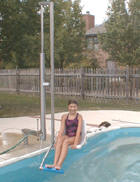
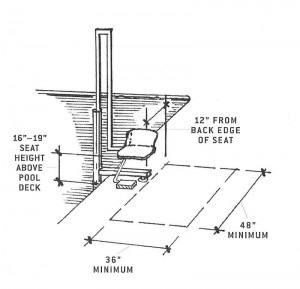
They are not required if the pool is deeper than 48″
Must be permanently installed.
Sloped Entry
They are just like ramps, but do not require slip resistant surface or handrail extensions.
Transfer Walls
Transfer System
Pools Stairs
If the pool is larger than 300 linear feet of pool wall, then two means of entry should be provided. At least one of the means of entry should be a lift or a sloped entry.
Swimming facilities- Per US Access Board
Aquatic Recreation Facilities
Wave action pools, leisure rivers, sand bottom pools, and other pools where access to the water is limited to one area and where everyone gets in and out at the same place, must provide at least one accessible means of entry, no matter how many linear feet of pool wall is provided. The accessible means of entry can be either a pool lift, sloped entry, or transfer system.
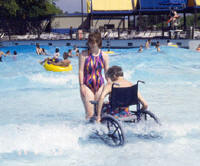
Catch Pools
A catch pool is a body of water where water slide flumes drop users into the water. An accessible means of entry or exit is not required into the catch pool. However, an accessible route must connect to the edge of the catch pool.
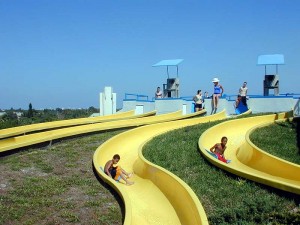
Wading Pools
A wading pool is a pool designed for shallow depth and is used for wading. Each wading pool must provide at least one sloped entry into the deepest part. Other forms of entry may be provided as long as a sloped entry is provided. The sloped entries for wading pools are not required to have handrails.
Spas
Spas must provide at least one accessible means of entry, which can be a pool lift, transfer wall, or transfer system. If spas are provided in a cluster, 5 percent of the total-or at least one spa-must be accessible. If there is more than one cluster, one spa or 5 percent per cluster must be accessible.
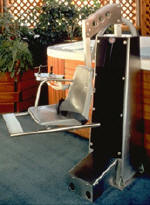
Footrests are not required on pool lifts provided at spas. However, footrests or retractable leg supports are encouraged, especially on lifts used in larger spas, where the water depth is 34 inches or more and there is sufficient space.
Department of Justice Requirements
Since swimming pools were not required to be accessible in the 1991 ADAAG, this brand new requirement applies to new construction that occurs after the mandatory date of March 15, 2012. But the DOJ also required that existing facilities be brought up to compliance “as it is readily achievable”. What this means is that means is that compliance should be achieved without much effort and expense.
For existing facilities with swimming pools, what this means is that the means of entry should be provided if there is enough money and if it does not cause undue burden for the building owner. These terms are very subjective and they must be backed up with financial proof. Many members of the hospitality industry were concerned about these new requirements, and therefore the DOJ gave an extension until May 15th to comply with these requirements. My colleague Ken Otten wrote a great blog about it. I recommend that you read it to gain a better understanding of this ruling.
What’s next….
Continuing Education:
May 2nd: DOJ will be having a free webinar explaining swimming pools. Register here
May 11th: AIA Knowledge Communities will have part 2 of the three part webinar about Universal Design. Space is limited, so sign up here
If you want to learn more about the new Standards, The ADA Companion Guide explains the 2004 ADAAG Guidelines with commentary and explanations throughout. The 2004 Guidelines were adopted by the DOJ to create the 2010 Standards and by Texas to create the 2012 TAS. This book explains the technical requirements for both.
If you have any questions about these or any other topics, please feel free to contact me anytime.
Marcela Abadi Rhoads, RAS #240
Abadi Accessibility
214. 403.8714
My children’s school principal told me a story today and I thought I’d share it with you…..
A cold and snowy day at a school in the North, where the custodian was shoveling snow off of the steps that lead up to the school entrance. At that moment a kid in a wheelchair asked the custodian
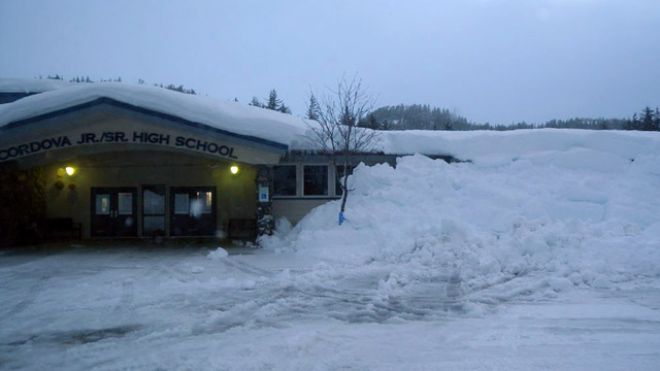
“Hey Mister, could you shovel the snow off of the ramp?”
The custodian gave the kid an annoyed look and said:
“Hey Kid, when I finish shoveling the snow off of the steps so that the 300 other kids can enter the school, then I’ll shovel the ramp for you!”
And then the very wise kid said:
“Well mister, if you shovel the snow off of the ramp EVERYONE can use it”
That is Universal Design!
Thank you Rabbi Udman for sharing and Rick Lavoie for telling it!
I live in Texas and have been following the Republican primary in other states. Now that the primaries are coming to our State I was informed by a very good interior designer and friend of mine (who shall remain nameless to protect her identity) that there are several polling centers that are not accessible. Even though the polling centers are only temporary, they are providing a “government program” which has to be made accessible. When someone votes, the service that the government is providing must be equal and available to everyone, including persons with disabilities.
This is what she wrote me:
“I have voted early for years to avoid the crowds. Yesterday and going back 6 years, I voted at polling sites where I have observed questionable Accessibility setups. All the pollworkers are volunteers (I think) who set up whatever space is given to them with instructions that are unknown to me. For two elections, I had absentee ballots so I do not know the conditions of the setup of voting tables, computer heights, etc. for those elections.
Six years ago, the voting was done at an elementary school on the auditorium stage accessed by about 6 or 8 steps. All the voting “booths” were stand up height and paper ballots were inserted into a counting machine. I am guessing that paper ballots were provided at the main floor level for wheelchair voters. Checking in for everyone was done at the main level where judges could assist voters.
Four years ago, at my local elementary school polling place, there were only the tall voting carrels separated from each other so there was some privacy provided by the distance between them. At that time, I asked why there was no H/C identifiable lower table for a wheelchair person to use. The poll worker was in a wheelchair and she pulled up to the high work surface and demonstrated how she could lift her arms to mark the ballot. Think bar height work surface being used from a seated chair height position.
Yesterday, at the polling place, all but two computer stations were located on 28″ high tables. The other two voting stations were the higher ones with no computers on them. I told the poll worker that I was concerned about the height of the machines for users, the H/C identified voting computer at the end of the table with the table leg in the way and did not go into the proximity of the stand up voting carrel to the tables with computers. The poll worker got his walker and we moved across the room to the area that I wanted to talk about. He had never heard of the ADA or TAS. The Dallas County Election Board is where they get their directives. Having been at the Dallas County Election Board as an observer of an election recount for a State Rep., I can assure you that the employees I met there likely have not heard of these regulations either. The poll worker explained to me that the computer with the H/C sign was for blind voters.
At that point, I just had to write to you to ask you to look at this photo and tell me what you see that I might have missed. I asked the poll worker to at least put the H/C sign on the computer in the center space. I felt it was futile to try to explain any more about having room under the table for the wheelchair and foot room.
This is Early Voting and Election Day is May 29th. I do not know if anything can be done prior to election day, but is there not a way to get RAS, architects and RID’s to look at their polling places to see if accomodations are being made?
Last time I mentioned this to my local precinct, the comments fell on deaf ears. When there is nothing in the poll worker’s experience that causes them to recognize any accessibility measure, then they just brush off my comments as complaints…and nothing gets done. “
My friend is right. Even though these are temporary places, they are still a voting place and will require some form of access. The voter who is disabled must be able to have the same privacy as everyone else. The voter who is disabled must have access to the same ballot and the same method of voting as everyone else. So how does a polling place provide this access? The ADA website has a pamphlet that they put out in 2004 that explains how to provide access even when the polling place is only temporary. The Election Assistance Commission has a video that is also helpful for polling places to provide access.
In a nutshell the following items need to be provided to the best of their ability, unless it is not feasible and then other accommodations should be provided to ensure that all voters, disabled or not, can cast their ballot:
1. Accessible parking or passenger drop off should be available

2. An Accessible route to the entrance
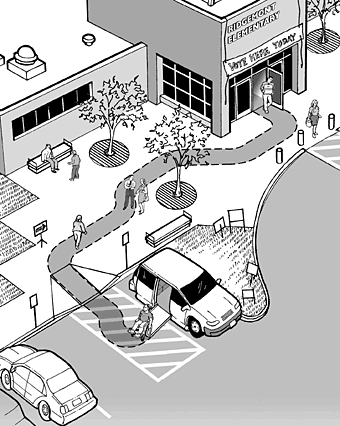
3. An accessible entrance to the voting site
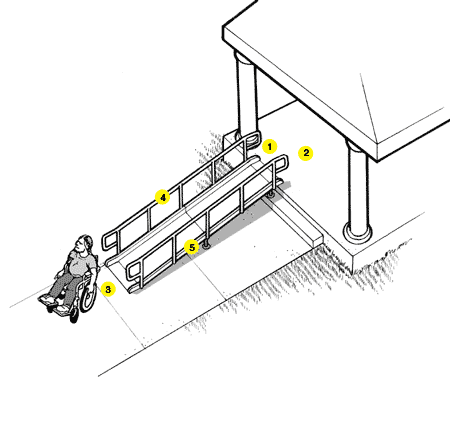
4. A route free from hazards
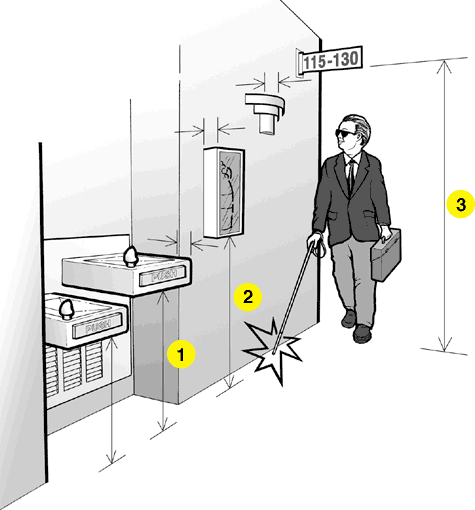
5- Counter or table where the voting is taking place should be between 28″-34″ in height and a forward approach knee space should be provided
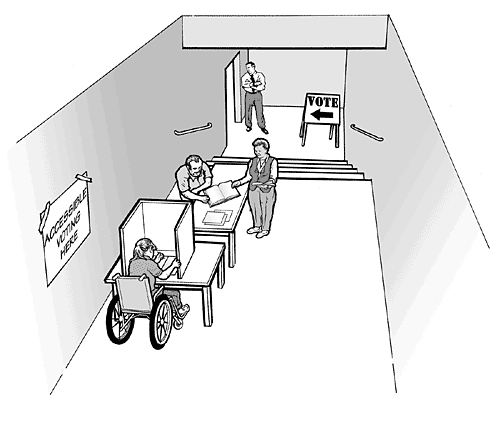
Everyone should go to their polling places and make sure there are facilities that are accessible for voters in wheelchairs, voters who are visually impaired as well as hearing impaired. Let’s try and make this election an accessible one.
Because the hospitality industry was confused and concerned about what to do with their existing swimming pools to make them accessible, the DOJ decided to extend the deadline for removing barriers until January 2013. The reality is that existing pools are not exempted, and will require access. But the DOJ understands the burden this may have on existing facilities and therefore will only require compliance as it is “readily achievable”. This means that when there is enough money and opportunity to remove the barriers (or in the case of pools provide access), then the operator should make that happen. The facility owner should have a plan in place for when they can make their pools accessible and start the process when it is achievable.
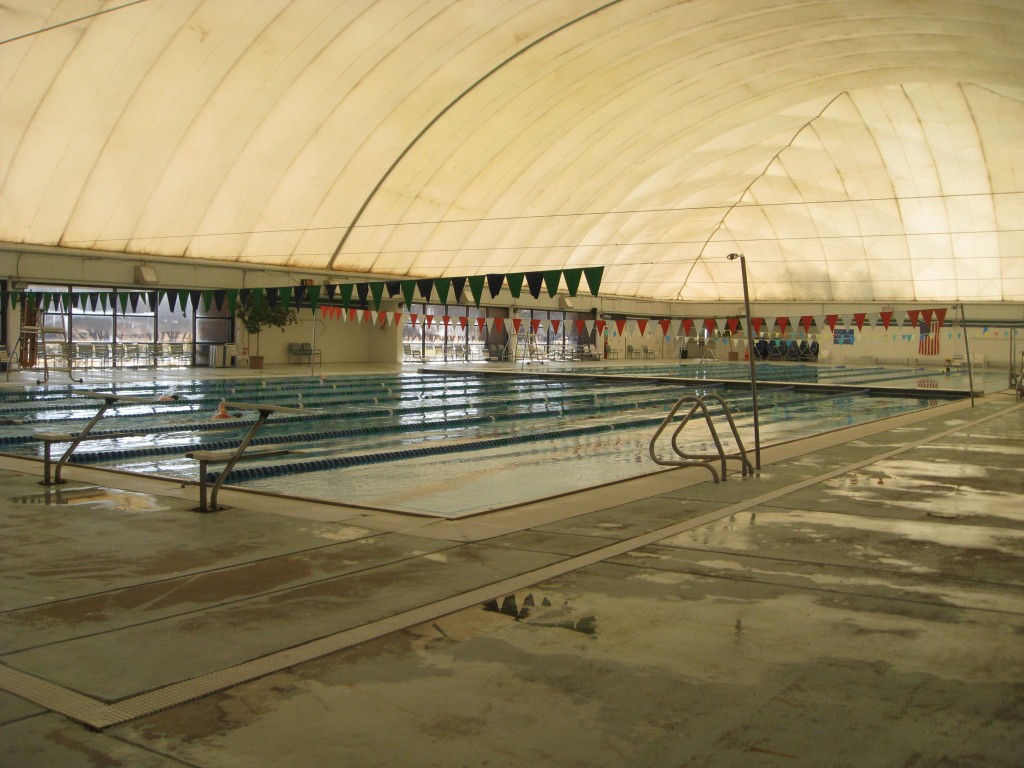
But until then, the DOJ has given everyone with existing pools an extension for this to happen.
Read the new rule here
My daughter Linda Hannah chose to write her 2nd grade research paper on Helen Keller! How wonderful. I am so proud of her and I wanted to share her report with you. I typed it since I didn’t have time to scan all her four pages (she only needed to write one page). Here is her report…enjoy!
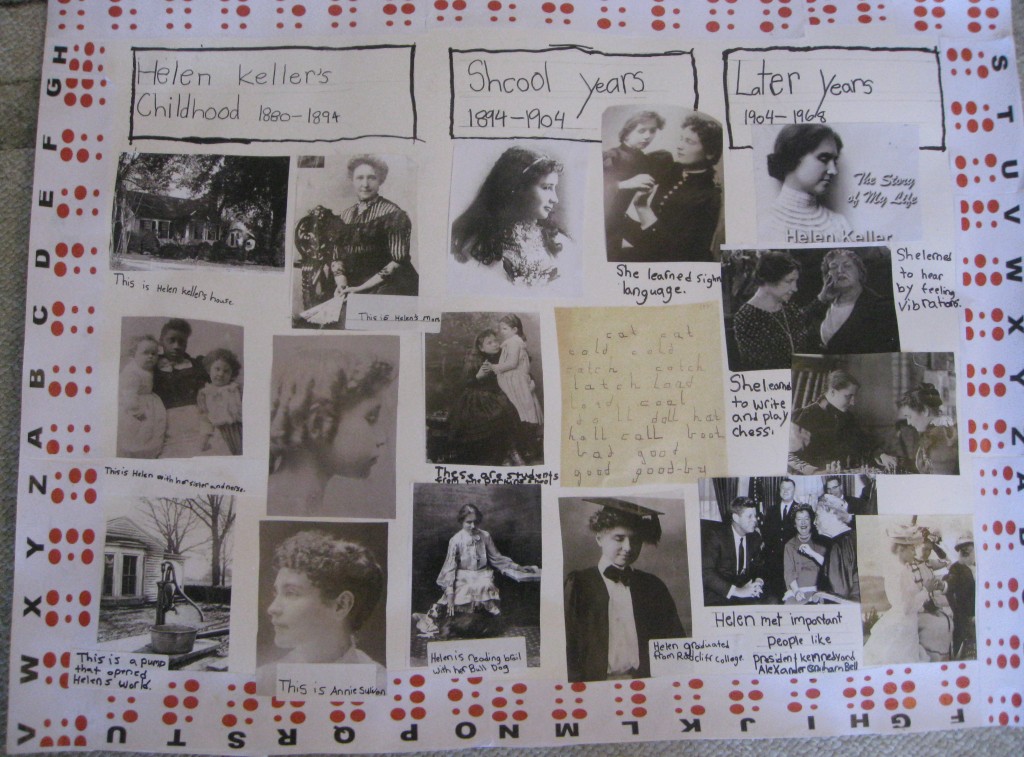
The Story of Helen Keller
By Linda Hannah Rhoads
May 1, 2012
Helen Keller was born in Tuscumbia Alabama on September 27, 1880. At the age of two she got an illness. The doctor she said she would probably die, but she didn’t. Instead of dying she was blind and deaf. She was a very mad and wild girl. She kicked her feet and screamed and ate from people’s plates and didn’t let her mother comb her hair. Her parents didn’t know what to do, so they went to see Doctor Alexander Graham Bell. He was a doctor of the deaf. He said to call the Perkins School, a school for blind children in Boston. A few weeks later, they got a letter from the Perkins school and they would send a teacher. When the teacher arrived Helen felt footsteps coming up her front porch. At first she thought it was her mother and she reached out her hand. But it wasn’t her mother, it was her teacher. Her teacher pulled her hand, and they went inside. Helen’s teacher was named Annie Sullivan.
At first Annie couldn’t control Helen wildness and temper. But then Annie made her into a better person. At first she taught her sign language. She gave Hellen a doll and Annie spelled D-O-L-L in Helen’s palm. And then Helen spelled D-O-L-L in Annie’s palm. Then she taught her cake, cat, hat, mat, and many other things. Helen’s parents were too easy on Helen, and she couldn’t learn , so Annie had to talk to Mr. Keller about moving into the backyard house. They took Helen for a long ride so that Helen could think that she was far away from home since she couldn’t see or hear she didn’t know. They arrived to the house and Annie and Helen learned lots of more things. One day Annie and Helen went for a walk. There was a water pump outside and Annie put Helen’s hand under the water pump. Annie started to pump water. Then Annie spelled water and Helen repeated. Then Helen understood everything. She understood that words were the most important things in the world. She wanted to learn more. She felt like she came back alive after being dead. Annie and Helen were so excited, Annie took Helen home and Annie told Mr. and Mrs. Keller the great news. Helen’s parents were excited when they heard the great news. They were very very proud of Helen. Annie wanted Helen to feel free and happy. Helen learned geography by making maps with wet dirt. Helen learned how to read Braille. Helen loved to read. Annie couldn’t teach her enough, so they went to visit the Perkins School for the Blind. Helen went to a real school for the first time of her life. Annie spelled out whatever the teacher was saying. Helen learned to speak by feeling people’s mouths. One of the first sentences she learned to say was “Mother I’m not dumb now”.
By the age of 10 Helen was famous. She had a fund raiser for a blind and deaf orphan named Tommy. She saved $1,600 to send Tommy to the Perkins School for the blind. Helen later wanted to go to college, but her friends thought it would be too hard. Helen did not give up her dream. Helen graduated from Radcliff college. Annie never gave up on Helen, and Helen never gave up on Annie. Helen helped blind and deaf children by making them feel better about themselves and also taught them how to read Braille. Helen traveled all over the world. She met President Kennedy and received an award for courage from President Kennedy. Helen liked to dance so she joined ballet. Helen made speeches all over the world. Helen wrote five books. Her first book was “The Story of My life”. Helen died in 1968. She was 88 years old. I would give Helen a medal for courage because she was brave because she could not see or hear. She taught the world you could do anything with hard work. I would like to be like her by being smart and brave.

 Abadi
Abadi 



